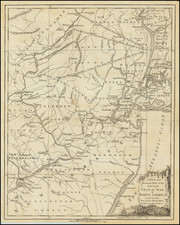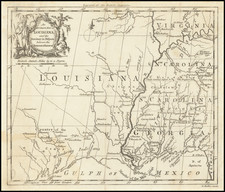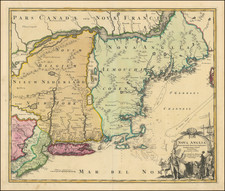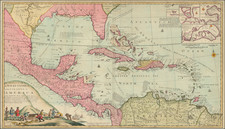Rare separately issued example of Jefferson's map, which was engraved from a manuscript draft drawn by Jefferson in 1786 while serving as a US Minister in Paris, to accompany his Notes on the State of Virginia. Much of the information in the maps derives from the most important regional maps of the period, including his father Joshua Fry's map of Virginia and Wiliam Scull's map of Pennsylvania. Another significant source is Thomas Hutchin's map of the western parts of Virginia, Pennsylvania, Maryland and North Carolina, published in 1778. However, Jefferson has supplemented Hutchin's work in several notable respects, including the addition of three proposed but as yet unnamed states Northwest of the Ohio River. In addition, Jefferson notes the new western settlements of Kentuckey and Frankland, the latter representing the earliest obtainable reference to the attempt by settlers in western Carolina to establish and seek recognition for the State of Franklin or Franklinia (including the appointment of John Sevier as Governor in 1784). It is likely that this map is the source of all other references to Frankland and Franklinia to appear on maps, as there are no American published maps which include this name. Jefferson had apparently intended to add county names, but had been unable to procure a copy of John Henry's scarece map of the colony. Jefferson arranged with Samuel J. Neele in September 1786 to have the map engraved, but the final product omits his name. A rare and important map of the region, and the only map attributable to Jefferson. While Jefferson's book (and the accompanying map) appear on the market in the French & English editions, the separately issued map, which is dissected and laid on linen, has been quite rare on the market. The map has been laid on fresh linen. There are three vertical splits, two at the right third, one along the left neat line. Despite the flaws, a good example of this important piece of Americana.
Sign In
The item illustrated and described below is sold, but we
have another example in stock. To view the example which
is currently being offered for sale, click the
"View Details" button below.
1787 Thomas Jefferson
$ 27,500.00
Stock# 10103
Description

![Notes on the State of Virginia [with the map:] A Map of the country between Albemarle Sound, and Lake Erie, comprehending the whole of Virginia, Maryland, Delaware, and Pensylvania, with parts of several other of the United States of America. Engraved for the Notes on Virginia. By Thomas Jefferson](https://storage.googleapis.com/raremaps/img/small/55181.jpg)











![Comparative Size of Lakes and Islands [Great Lakes, Cuba, Formosa, Ireland, Sicily, Cyprus, Vancouver, Sandwich Islands, Puerto Rico, Corsica, Sardinia, Balearics, Malta, etc]](https://storage.googleapis.com/raremaps/img/small/92574.jpg)
![[ Virginia, Carolinas, Georgia ] Carte De la Virginie . . .](https://storage.googleapis.com/raremaps/img/small/41731.jpg)
